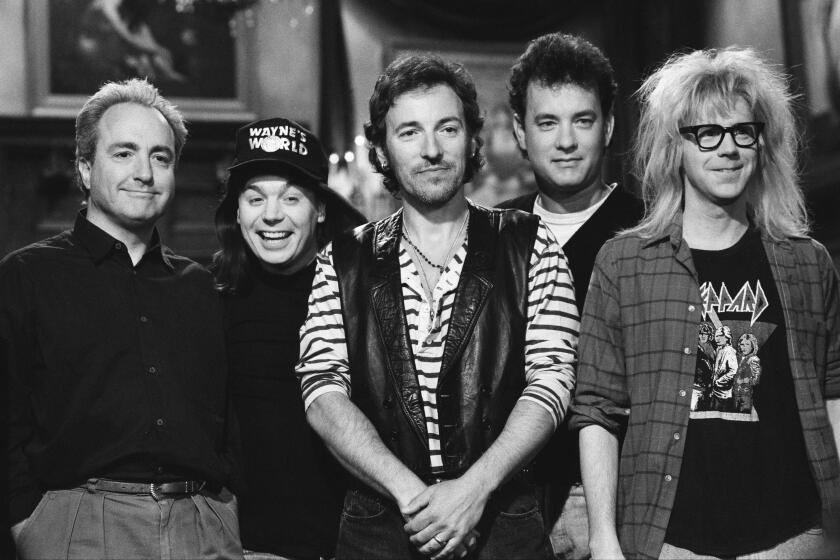Stage of the Union : Theater: In an outdoor setting in Topanga Canyon, schoolchildren receive a lively lesson in labor history.
- Share via
The Will Geer Theatricum Botanicum in Topanga Canyon is an engaging place to introduce youngsters to Shakespeare, and since 1979 hundreds of Los Angeles-area schools have done just that.
In the parklike area where the family of the late actor Geer built the outdoor theater, more than 40,000 elementary school students have sat under giant sycamores and listened to the Bard’s fast-flying dialogue.
But this day, on the multilevel stage rising above a brook, something entirely different was on tap for visiting fourth-, fifth- and sixth-grade students from St. Martin-in-the-Fields School in Canoga Park, Walnut School of Newbury Park and Woodland Hills Elementary School.
There was no Lysander and Demetrius noisily lusting after the fair Hermia, no Robin Goodfellow puckishly mucking up the course of true love.
Instead of watching “A Midsummer Night’s Dream,” these 120 youngsters were hearing about trade unions and collective bargaining, about such tragedies as the Triangle shirt factory fire and the Matewan incident.
The history of American unions from the 1800s to the present might not seem to be riveting stuff for youngsters who think a labor movement is something to do with their mom’s Lamaze class.
But “Worker’s U.S.A.!” keeps a lively pace as it traces the struggle to empower American workers through the words of such history-making figures as Abraham Lincoln, Eugene Debs, Mother Jones and Cesar Chavez.
“On a scale of 1 to 10, I’d give it a 100,” said Carey Skinner, one of teacher Nancy Tsurunaga’s fifth-graders from Woodland Hills Elementary School.
“I found out how hard poor people and blacks had it before unions, and about child labor, how a child of 10 could become a hunchback,” said another, Cori Wang.
“I liked the way they used the words real people in history used,” added Graham Zajaczkowski.
“I liked the part where Harriet Tubman took the slaves to freedom,” Carlos Martinez said.
Jeff Wright, Mike Treanor and Eric Carll, who came with Carol Nasby’s sixth-grade class from St. Martin, said they liked the experience of being outdoors, seeing the play, getting an idea about what labor unions were all about.
“I was happy the students got to see the play because they are studying American history and it works with our curriculum,” Tsurunaga said, getting back to business.
She added that she thought the play was heavily weighted on the side of unions, and maybe something should be said about capitalists “who aren’t robber barons.” But on the whole, the experience was a positive one for her.
Nasby of St. Martin said she was not sure how much her students would remember about the different people in the play, but the class would soon be working with some of the material that the play covered.
“I think it was a fairly idealistic telling of the movement,” said another teacher who accompanied her youngsters to the performance. “I think it was a personal view of how things happened and made no effort to portray management’s side, but I am still glad the kids had an opportunity to see it, because it gives us so much to talk about in our American history class.”
If the union movement is romanticized and dramatized, and represents an idiosyncratic point of view, the play’s anthologist, Ellen Geer, is simply reflecting what she knows.
“We believe in unions in my family, and the idea of people sticking together to help and support each other,” Geer said, sitting down on a stage tier after the performance.
“I remember when Papa bought this property in 1951,” she continued, looking around the now nearly empty amphitheater.
“He had been blacklisted during the McCarthy era and couldn’t get work, so he bought this land and we all farmed it,” she said.
For one three-year period, before her father became Grandpa on television’s “The Waltons,” the family was so poor they were homeless and lived hand-to-mouth. “Mama held us together,” Geer said of her now 78-year-old mother, Herta Ware, who like Geer is part of the “Worker’s U.S.A.!” cast.
During the lean times her father may not have had money, but he was never without purpose.
“Papa and (folksinger-activist) Woody Guthrie used to go to labor rallies to help raise money for the workers,” she said. “Papa believed in unions because he knew what happened when the common man was unprotected.
“The history of the labor movement is a story about people uniting to address terrible conditions. We should remember how hard those people fought for the right to organize.”
Toward that end, Geer began compiling the scripts for the performance several years ago and began performing it with the Botanicum troupe last season.
“Last year we had some information about the Vietnam War,” Geer said, but that’s been dropped in favor of material about the itinerant farm workers’ battle against pesticides.
“I was really excited that the kids were so eager during the question-and-answer period,” Geer said. “I like it when they asked more questions about what happened to some of the people in the play.”
“Worker’s U.S.A.!” will be performed several more times in Topanga Canyon before the play moves to the stage at Elysian Park on May 30, when students from Toll Junior High School in Glendale will be in the audience.
In addition to the performances for students, the play will be performed for the general public at 1:30 p.m. Sundays June 9 through Sept. 1 in the amphitheater.
More to Read
The biggest entertainment stories
Get our big stories about Hollywood, film, television, music, arts, culture and more right in your inbox as soon as they publish.
You may occasionally receive promotional content from the Los Angeles Times.










